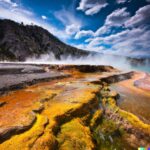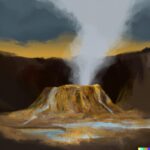Welcome to the fascinating world of Yellowstone National Park’s geyser basins! In this article, we will explore the wonders of geothermal activity, the different types of geysers found in the basins, and the most famous geyser basins in the park.
Discover what makes Yellowstone’s geyser basins so unique and learn about the safety precautions you need to take when visiting these natural wonders. So, let’s dive into the intriguing world of geysers in Yellowstone National Park!
What Are Geyser Basins?
Geyser basins are areas within Yellowstone National Park characterized by spectacular geothermal features and thermal activity.
These basins play a pivotal role in showcasing the dynamic geological forces at work beneath the surface of the park. Visitors are mesmerized by the bubbling hot springs, colorful microbial mats, and the eruption of iconic geysers like Old Faithful. The hydrothermal features found in these basins are a result of the park’s location atop a supervolcano, creating a unique landscape unlike anywhere else on Earth. Exploring these areas offers a glimpse into the raw power and beauty of nature’s thermal wonders.
Where Are The Geyser Basins Located In Yellowstone National Park?
The geyser basins in Yellowstone National Park are strategically distributed across the park’s vast volcanic landscape.
This distribution showcases the geological diversity of the park, with notable basins like the Upper Geyser Basin near Old Faithful, known for its high concentration of geysers and hot springs. Moving towards the west, the Norris Geyser Basin stands out for its dynamic geothermal features and constantly changing landscape. In the southwest region, visitors can explore the Lower Geyser Basin with its fascinating bubbling mud pots and colorful thermal pools. This strategic placement allows visitors to witness the different stages of volcanic activity and hydrothermal processes within Yellowstone’s unique ecosystem.
What Makes Yellowstone National Park Geyser Basins Unique?
Yellowstone National Park’s geyser basins stand out due to their extraordinary geothermal features, diverse thermal activity, and rich biodiversity.
These basins are home to a stunning array of hydrothermal features, ranging from geysers that erupt with impressive force to bubbling mud pots and colorful hot springs. The geothermal energy that powers these phenomena creates a dynamic landscape that is constantly evolving. This unique geologic activity not only attracts visitors from around the world but also supports a diverse range of plant and animal species that have adapted to thrive in the extreme conditions found within the basins.
What Is The Geothermal Activity In Yellowstone National Park?
The geothermal activity in Yellowstone National Park is a result of the park’s underlying volcanic landscape, manifesting in various thermal features that attract scientific research and study.
These thermal features, such as geysers, hot springs, mud pots, and fumaroles, are driven by the heat generated beneath the Earth’s crust. The unique combination of geological forces at play in Yellowstone creates a natural laboratory for researchers to study geothermal processes and their impact on ecosystems.
The hydrothermal activity in the park provides valuable insights into understanding Earth’s geology, energy sources, and potential applications for geothermal energy production. Ongoing research efforts focus on monitoring changes in the park’s thermal features to better predict volcanic activity and protect the surrounding environment.”
What Are The Different Types Of Geysers Found In The Geyser Basins?
The geyser basins in Yellowstone National Park host a variety of geyser types, each displaying unique eruption patterns and geological formations.
Some of the notable geyser types found in Yellowstone include cone geysers, which typically erupt in a vertical column of water and steam. Fountain geysers, on the other hand, produce bursts of water at varying angles. There are also the impressive steamboat geysers that shoot water in towering bursts. The complex interplay of underground hydrothermal systems and the diverse geological structures contribute to the rich tapestry of geothermal wonders in the park’s geyser basins.
Fountain Geysers
Fountain Geysers in Yellowstone National Park are known for their impressive thermal pools and dramatic steam vents, creating captivating natural spectacles.
Visitors to the park are often mesmerized by the kaleidoscope of colors that dance on the surface of the thermal pools, ranging from brilliant blues to vibrant oranges, due to the presence of thermophilic bacteria.
The steam vents, like dragon’s breath, release billowing clouds of steam into the air, adding an element of mystery and wonder to the landscape.
The contrast between the bubbling pools and the hissing vents against the backdrop of the park’s rugged terrain offers a truly unforgettable experience for all who come to witness these remarkable geothermal features.
Cone Geysers
Cone Geysers found in Yellowstone National Park exhibit distinct volcanic activity and eruption patterns, showcasing the dynamic nature of geothermal processes.
The cone formations of these geysers are a result of mineral deposits accumulating over time as the hot water rises and evaporates, creating unique structures that can vary in size and shape.
Eruption styles of Cone Geysers can range from regular, predictable bursts to more sporadic and powerful outbursts, influenced by factors such as underground water pressure and temperature fluctuations. Understanding the relationship between volcanic activity and the geyser’s behavior is crucial in predicting and studying the potential impact of volcanic events on these natural wonders.
Fountain-Cone Geysers
Fountain-Cone Geysers in Yellowstone National Park combine elements of both fountain and cone formations, offering insights into the park’s intricate geology and hydrology.
These geysers are known for their unique shape and behavior, where they erupt with bursts of water shooting up like a fountain, only to settle down and create cone-shaped deposits around their vents. The geological formation of these geysers is a result of the intricate underground plumbing system that allows for the build-up of pressure and the eventual release of steam and water. This interplay between different geyser types in the park creates a dynamic landscape filled with geothermal wonders waiting to be explored.
Erupting Geysers
Erupting Geysers in Yellowstone National Park, such as the iconic Steamboat Geyser, showcase powerful and unpredictable eruption patterns that captivate visitors.
These natural wonders are known for their ability to shoot scalding water and steam high into the air, creating a mesmerizing display of nature’s forces. The eruption dynamics of geysers like Steamboat Geyser are influenced by a complex interplay of underground water pressure and geothermal activity. Visitors to Yellowstone are often left in awe as they witness these geysers spout boiling water with tremendous force, reminding them of the Earth’s immense power lurking just below the surface.
Non-Erupting Geysers
Non-Erupting Geysers in Yellowstone National Park contribute to the park’s diversity of thermal features and serve as windows into the region’s volcanic landscape.
These geysers, also known as dormant geysers, play a crucial role in the park’s thermal ecosystem by providing insights into the underground geothermal activity. Unlike their erupting counterparts, non-erupting geysers showcase distinct characteristics such as tranquil pools of warm, steaming water that create a serene and mesmerizing atmosphere. Their presence offers a glimpse into the broader volcanic activity in the area, highlighting the intricate connections between the subterranean geothermal processes and the surface manifestations observed throughout the park.
What Are The Most Famous Geyser Basins In Yellowstone National Park?
Yellowstone National Park boasts several world-renowned geyser basins that are revered as iconic park attractions and natural wonders.
- One such popular geyser basin within Yellowstone is the Upper Geyser Basin, home to the famous Old Faithful geyser, known for its regular and impressive eruptions that draw crowds of visitors.
- The Norris Geyser Basin is another top choice, featuring unique geothermal features like steam vents and colorful hot springs, providing a captivating display of nature’s power.
- Visitors also flock to the Mammoth Hot Springs, where terraces of travertine formations create a stunning and ever-changing landscape of cascading mineral-rich waters.
Upper Geyser Basin
The Upper Geyser Basin in Yellowstone National Park features the famous Old Faithful geyser and serves as a hub of geothermal energy and activity.
Surrounding Old Faithful are a myriad of other geysers, hot springs, and mud pots that collectively create a dynamic and unique geothermal landscape. The geyser’s eruptive patterns, with intervals between eruptions ranging from approximately 60 to 110 minutes, draw in crowds of visitors eagerly waiting to witness its majestic display. Apart from its natural beauty, the region’s geothermal activity also plays a crucial role in scientific research and sustainable energy initiatives, showcasing the power and potential of harnessing renewable energy sources.
Norris Geyser Basin
Norris Geyser Basin in Yellowstone National Park showcases unique geological formations and diverse geyser eruption patterns, attracting visitors with its natural wonders.
One of the remarkable features of Norris Geyser Basin is the presence of the world’s tallest active geyser, Steamboat Geyser, known for its sporadic but powerful eruptions that can reach heights of over 300 feet, captivating onlookers with its impressive display of nature’s force.
The basin also boasts an array of colorful hot springs, bubbling mud pots, and fumaroles, each offering a different visual and sensory experience. The continuous simmering and bubbling of these geothermal features create a surreal landscape that showcases the raw power and beauty of Yellowstone’s hydrothermal wonders.
Lower Geyser Basin
The Lower Geyser Basin in Yellowstone National Park is renowned for its vibrant thermal pools, bubbling hot springs, and captivating hydrothermal features.
Visitors to this unique area can witness the dynamic forces of nature at work, as steam rises from the colorful pools creating a mesmerizing sight against the backdrop of the lush forest. Walking along the boardwalks, one can feel the heat radiating from the geothermal wonders, a stark reminder of the earth’s immense power just beneath our feet. The diversity of geothermal features here, from fumaroles to geysers like the famous Fountain Paint Pot, offers a fascinating insight into the volcanic activity shaping the landscape.
West Thumb Geyser Basin
The West Thumb Geyser Basin in Yellowstone National Park offers a unique blend of thermal features, ecological systems, and a focus on environmental conservation.
Visitors to West Thumb Geyser Basin can marvel at the colorful hot springs, boiling geysers, and bubbling mudpots that highlight the area’s geothermal activity. This thermal landscape provides a habitat for thermophiles, heat-loving microorganisms, which play a crucial role in the basin’s unique ecosystem.
The diverse flora and fauna surrounding the thermal features have adapted to the extreme conditions, showcasing nature’s resilience. Conservation efforts in the basin aim to protect these fragile ecosystems and maintain the delicate balance of the natural environment for future generations to appreciate and enjoy.
What Are The Safety Precautions When Visiting Geyser Basins?
When visiting geyser basins in Yellowstone National Park, it is crucial to adhere to safety precautions outlined by park management for an enriching visitor experience.
One of the key safety measures is to always stay on designated paths to avoid potentially dangerous encounters with geothermal features. Park regulations are in place to protect both visitors and the fragile ecosystem of the geysers. It is important to be mindful of geothermal hazards, such as hot springs and unpredictable geysers, by keeping a safe distance and following warning signs. By respecting these guidelines, visitors can safely enjoy the unique beauty and natural wonders of the geyser basins.
Stay On Boardwalks And Trails
One of the key safety precautions when visiting geyser basins in Yellowstone National Park is to stay on designated boardwalks and trails to avoid geothermal hazards.
These designated paths are specifically designed to keep visitors safe by guiding them through areas where the ground may be unstable or fragile due to geothermal activity. Straying off the boardwalks or trails can pose significant risks, including encountering scalding water, unstable ground that can collapse underfoot, or toxic gases.
It’s crucial for visitors to adhere to these safety measures to protect themselves and preserve the delicate geothermal features for future generations. Park authorities continually stress the importance of respecting the designated paths for the well-being of all visitors.
Follow Park Rules And Regulations
Visitors should prioritize following all park rules and regulations when exploring geyser basins in Yellowstone National Park to ensure their safety and preserve the natural environment.
Abiding by these regulations is crucial in preventing accidents and minimizing human impact on the delicate ecosystems within the park. Rules such as staying on designated trails help protect fragile vegetation and wildlife habitats. Compliance with regulations also plays a significant role in maintaining the natural beauty of the park for future generations to enjoy. By respecting these guidelines, visitors contribute to the overall conservation efforts and sustainable management of Yellowstone National Park, ensuring its long-term preservation and viability as a natural wonder.
Be Aware Of Geothermal Hazards
Understanding and being aware of geothermal hazards is essential for visitors exploring geyser basins in Yellowstone National Park to prevent accidents and ensure a safe experience.
The unique landscape of Yellowstone presents a playground of natural wonders, from bubbling hot springs to hissing steam vents. While these geothermal features are captivating, they also pose inherent dangers to the unwary. The scalding temperatures of the thermal waters, the unpredictable eruptions of geysers, and the hidden hazards beneath the seemingly tranquil surfaces all underscore the importance of observing caution and heeding warning signs. Respect for nature’s power and proper safety measures are crucial elements for enjoying the park’s geothermal wonders responsibly.
Last Updated on February 11, 2024 by Jon Waraas – Originally Posted: February 11, 2024

I’m Jon Waraas, and I’ve been navigating the online world since 2006. By day, I’m the proud owner of some eCommerce gems, and by night, I’m the voice behind the adventures on Waraas.Com.
My heart, however, belongs to the wild beauty of Yellowstone National Park. I’ve got a collection of websites dedicated to sharing the wonders of this natural masterpiece. Oh, and did I mention? I’m currently building my own cabin inside the ghost town of Gilmore, Idaho – a cabin with tales to tell!
When I’m not immersed in the digital realm, you’ll find me lacing up my boots for a good hike or setting up camp under the star-studded sky.




